Table of Contents forth above, we did not have any off-balance sheet arrangements as of June 30, 2019. Our unconsolidated investments are discussed in Note 11 of the unaudited interim condensed consolidated financial statements included elsewhere in this prospectus. Quantitative and Qualitative Disclosures About Market Risks Interest Rate Risk We have market risk exposure arising from changes in interest rates on the revolving loans under the credit agreement, which bears interest at rates that are benchmarked against the Federal Funds Rate, Prime and LIBOR. However, as of June 30, 2019, there were no loans outstanding under the credit agreement and the payments due on the $1.0 billion of outstanding stand-by letters of credit and the unused portion represent a fixed 1.5% of the amount outstanding and 0.375% of the unused amount. These letters of credit were secured by restricted cash of $478.9 million as of June 30, 2019. There were no other borrowings outstanding under the credit agreement as of June 30, 2019. We also have market risk exposure arising from changes in interest rates on the 424 Fifth Venture loans, totaling $626.0 million as of June 30, 2019, which bear interest rates benchmarked against LIBOR. The 424 Fifth Venture loan agreements include a LIBOR floor of 2.513% and a LIBOR cap of 4%. The LIBOR interest rate cap expires on February 8, 2021. Foreign Currency Risk The U.S. dollar is the functional currency of our consolidated and unconsolidated entities operating in the United States. For our consolidated and unconsolidated entities operating outside of the United States, we generally assign the relevant local currency as the functional currency, as the local currency is generally the principal currency of the economic environment in which the foreign entity primarily generates and expends cash. Our international operating companies typically earn revenue and incur expenses in local currencies that are consistent with the functional currency of the relevant entity, and therefore they are not subject to significant foreign currency risk in their daily operations. However, as exchange rates may fluctuate between periods, revenue and operating expenses, when converted into U.S. dollars, may also fluctuate between periods. For the six months ended June 30, 2019, we earned approximately 44% of our revenues from subsidiaries whose functional currency is not the U.S. dollar. Although we are impacted by the exchange rate movements from a number of currencies relative to the U.S. dollar, our results of operations are primarily impacted by fluctuations in the U.S. dollar-Euro, U.S. dollar-British Pound and U.S. dollar-Chinese Yuan exchange rate. We hold cash and cash equivalents in foreign currencies to have funds available for use by our international operations. In addition, monetary intercompany transactions that are not of a long-term investment nature may be denominated in currencies other than the U.S. dollar and/or in a different currency than the respective entity’s functional currency. As a result, we are subject to foreign currency risk and changes in foreign currency exchange rates can impact the foreign currency gain (loss) recorded in our consolidated statements of operations relating to these monetary intercompany transactions. As of June 30, 2019, we had a balance of $415.6 million in cash and cash equivalents, $3.7 billion in various other monetary assets and $2.6 billion in various other monetary liabilities that were subject to foreign currency risk. A 10% change in the relevant exchange rates would result in a total net change of $153.6 million in foreign currency gain or loss on these transactions. Inflation Risk Inflationary factors such as increases in the cost of raw materials and overhead costs may adversely affect our results of operations. We do not believe that inflation has had a material effect on our business, financial condition or results of operations to date. If our costs were to become subject to significant inflationary pressures, we may not be able to fully offset such higher costs through higher membership fees or price increases for services. Our inability or failure to do so could harm our business, financial condition or results of operations. Critical Accounting Estimates, Significant Accounting Policies and New Accounting Standards Not Yet Adopted Our preparation of financial statements in accordance with GAAP requires management to make estimates and assumptions that affect reported amounts and related disclosures. Management considers an accounting policy 123
 S1 - WeWork Prospectus Page 127 Page 129
S1 - WeWork Prospectus Page 127 Page 129